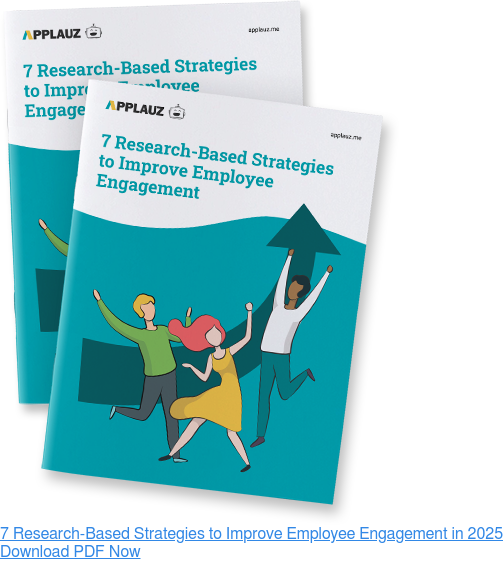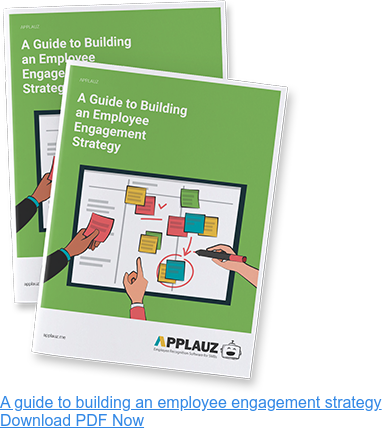As an HR professional, you want to advocate for your employees and keep them happy and engaged. But it's a balancing act. Your company is very budget conscious and unlocking funds for employee engagement can prove to be difficult for many HR teams.
This is especially true for small to medium-sized businesses.
But the good news is, you create a fun, exciting work atmosphere on a budget. All it takes is a little creativity and time. Because what drives genuine, long-term employee engagement is not singular activities or lavish perks, but rather intangible factors like:
- Autonomy
- Strong coworker relationships
- Feeling appreciated
- Receiving feedback
- Meaning & purpose
- Rest
Creating an engaging work environment
To be clear, fun perks are a great way to boost morale and build an enticing employer brand. But they are only one piece of the pie of an employee engagement program and strategy.
That said, in this list, we include a mix of both tangible and intangible ideas to help you drive greater engagement.
But most importantly, the ideas listed are surprisingly cost-effective, if not absolutely free. What they do require are some time and dedication. But it will be time well spent as you will be actively working towards greater engagement.
Employee Engagement Ideas For HR teams on a Budget
-
Start a company “newsletter”
Think about the day-to-day life of your company's employees. When in the daily grind, it's easy to lose sight of the bigger picture. In other words, it's easy for employees to lose touch with how their work contributes to the company as a whole.
When employees lose sight of their work's impact, feelings of disengagement are likely to start brewing under the surface.
People want to feel a sense of purpose at work like our efforts connect to something bigger and long-term. HR and other company leaders play a pivotal role in explaining this long-term vision for the company's employees.
That said, think about all the events that happen in a given week: new hires, promotions, new clients, new developments. These are exciting pieces of information! Your company is growing and changing. Keeping workers in the loop of these changes and showing the impact of their work is a great way to engage and build trust with employees.
Bottom line: A company Newsletter is an ideal way to broadcast important company news and events. But most importantly, this initiative would help keep employees tied to long-term purpose and boost that emotional connection crucial for engagement.
-
Plan yearly company presentations
Keeping employees connected to the bigger picture can be achieved through other means as well. A yearly company presentation is a great way to perform many critical engagement-driving actions, such as:
- Keeping workers in touch with the significant accomplishments and milestones of the company.
- Company leaders can publicly recognize important teams and departments.
- Company leaders can articulate the company's goals for the upcoming year.
After a year of working hard, listening to company executives or leaders talk about the company's significant achievements can feel very gratifying and motivating. Not to mention, an official gathering of all the company's employees can boost feelings of belonging and camaraderie. It's not often everyone has a chance to be in the same room.
If you have a budget or a smaller team, you can take your yearly presentation a step further. Offer employees lunch and a few hours off in the afternoon to celebrate and mingle after the presentation. An essential part of creating engagement is giving employees free time to celebrate their big wins and build relationships with coworkers.
-
Institutionalize recognition or appreciation meetings
The great thing about offering gratitude is it's powerful and free! The same goes for employee recognition; it does not have to be expensive to be effective and impact employee sentiment.
It's all about making sure employees are being valued and appreciated for their excellent work. Giving more recognition and appreciation to employees can be achieved; the first and essential step is to create a dedicated space for recognition.

You can create a "space" for recognition by instituting appreciation meetings or saving the last 15 minutes of an all-hands meeting for shout-outs and recognition.
If your company is working with a chat tool like Slack, you can create a "recognition" channel on your company chat. This channel should be reserved only for shout-outs and praise.
There are many ways to make employee recognition more of a priority in your company. And many of these solutions cost little to no money at all. It only takes time and effort to set up a new practice and encourage people to get involved and help them create new habits.
-
Give employee shout-outs on social media
Many companies use their social media pages, especially professional networks like Linkedin, to give visibility to employee achievements.
Posting about employees on social media achieves a few objectives. Most importantly, it helps to boost morale among current employees. They can share these posts on their pages for their friends and family to see. Secondly, these public shout-outs to employees will also help develop your company’s public image and build a strong employer brand.
That said, you would want to start with a structure for these employee announcements. For example, ask yourself what types of achievements warrant a social media shout-out. Or do you want to create a nomination system? Collaborating with your company’s marketing department or social media specialist would be the next step to develop an action plan.
-
Establish flexible schedules
Autonomy is a core driver of employee engagement. Having autonomy at work involves having some level of freedom and accountability for when your work gets done.
Luckily, the COVID-19 pandemic forced many companies to become more flexible regarding working arrangements and allowing employees to work from home. This "work from home experiment" made the power of flexible working schedules even more apparent. A growing number of employee surveys and studies confirm that most employees want to continue working from home indefinitely.
But working from home isn't the only way to encourage flexibility. Your business can promote flexibility in several ways.
For example, you can give managers more freedom to work with employees to find a schedule that fits their needs and life. We all know flexible hours can also do wonders for productivity. It's all about supporting a healthy work-life balance with concrete policies.
-
Celebrate employee anniversaries
When an employee is celebrating a work anniversary (whether it's one year or five years), it's crucial to acknowledge their loyalty. All it takes is a small gift or celebration. It's the thought that counts. Even if your business doesn't have the resources to implement an official Service Awards Program for anniversaries, it doesn't matter.
For instance, you can offer a small budget to managers to host a small lunchtime get-together or make sure managers offer heartfelt handwritten anniversary letters. These are some of the easy and inexpensive anniversary ideas that leave a positive impression.
Conversely, failing to acknowledge a work anniversary can lead to resentment and negative feelings. Anniversaries are a time for evaluating your current job and happiness, so it's crucial to leave your employees with a positive impression of your company and its culture.
-
Institutionalize quarterly focus groups
To engage with someone means giving them your attention, listening attentively, and hearing what they have to say. To that end, a core part of engaging employees is to listen to employees and understand what they need from your company.
Of course, a standard method for gathering this type of feedback is satisfaction surveys. One of the benefits of these surveys is that they are anonymous so that employees can be honest. However, the drawback is that surveys only allow for fixed answers. In short, It's not a two-way conversation. As a result, HR doesn't get any subjective feedback.
To that end, focus group interviews are a great way to show employees that you care about what they have to say. This will not only generate ideas and feedback for your HR team. But taking the time to hear what employees have to say incites engagement because employees feel that their company cares about them.
-
Offer a learning budget
Employees want to grow their knowledge and their skills at work. On the flip side, when employees feel they are not improving their skills or advancing professionally, they are more likely to feel disengaged at work.
Your company can support professional development and growth in many ways.

One simple and affordable way to do so is with a learning budget. I know the word “budget” may seem like this idea would incur a high cost. But in reality, there are many affordable learning and educational resources online. Some examples are online courses, subscriptions, books, and other forms of content.
You can offer each team a quarterly learning budget to buy books or enroll in online courses that help them learn something new and develop their skills. This initiative will engage employees and help your business grow, as your employees will be learning new skills and knowledge they can apply to their work.
-
Prioritize regular social activities
Small businesses have a significant advantage -- everyone knows each other. This creates the experience of working with a group of friends or like you are a "family." Take advantage of that close-knit spirit and launch a culture committee focused on planning social activities to bring people together.
For example, board game happy hours, barbecues, social Fridays, team lunches, etc. SMBs can foster a positive work environment and distinguish themselves from their competitors with collaborative, friendly environments.
-
Be pet-friendly
It's becoming increasingly popular to allow people to bring their dogs to work. This initiative can get messy if too many people bring their animals. But in small amounts, this initiative is a simple and cost-effective way to boost employee morale. For example, consider one day a month or a quarter where employees can bring their dogs to work.
Some studies even show a real, positive impact of the presence of furry friends. A Purina survey found that 80% of employees in pet-friendly workplaces say having pets nearby makes them feel "happy, relaxed and sociable" at work.
-
Provide food treats and freebies
Whether it's a fruit basket or muffins or bagels every other Friday, healthy and delicious snacks are an affordable way for any business to improve happiness and morale.
Remember, though: Perks like these aren't a cure for serious engagement issues. Instead, think of food freebies as valuable perks for maintaining happiness within a team that is already healthy and collaborative.
-
Host a monthly or seasonal wellness challenge
A wellness challenge can take on many forms. It all depends on the type of wellness activities you want to support.
A safe place to start is by getting people to participate in any wellness activity. It can be running, yoga, meditation, hiking, cooking, drawing -- it's up to you, and count points for each activity.
Every week, participants submit the activities they completed. They can keep track by taking pictures or recording it with a fitness app or watch.
At the end of the month, you tally up the points to see which people performed the most wellness activities — award small prizes to the winners.
This idea is excellent for virtual teams who are working from home. Sharing the pictures of activities with each other allows people to get to know each other better and creates friendly competition. And not to mention, this activity might even get people to adopt better lifestyle habits or try something new!
-
Launch "Think Tank" innovation sessions
Giving your employees time to work on special projects that matter to them is a great way to show your workforce your support initiative, learning, innovation, and creativity.
You can also host quarterly or monthly "think tank" meetings, and make sure to invite everyone. Anyone in the company (regardless of their official title) should be invited to share and brainstorm ideas.
Hosting a Think Tank communicates to all your employees that you value them and trust their input and expertise. Your employees can only thank you for it.
-
Subsidize outside fitness classes
On-site fitness classes and in-office gyms are costly. And, realistically, only a small fraction of your employees may take advantage of them.
However, you have other options to support employee wellness. For example, you can offer employees a monthly credit of $20 to partially pay for gym memberships, yoga classes, or any other health and wellness activities.
Offering wellness credits is not only a great perk; it gives employees total flexibility. For instance--instead of making employees work out at the office gym (which might not be comfortable for everyone), they can choose the activity of their choice. This initiative will surely be an attractive benefit for employees who are already into fitness. And it will maybe even entice some others to begin adopting healthier lifestyle choices.
-
Plan virtual activities and games
Your company’s employees are likely working from home, at least some of the time. If that’s the case, then planning social events can be all the more challenging. But there are plenty of virtual activities and team-building exercises that you can do digitally.
For example, you can play trivia games, quizzes, virtual Jeopardy, and other games, all while everyone works from home. Check out our article on team-building activities for remote employees for more ideas and inspiration.
-
Build a peer recognition program
Recognition from leaders and managers boosts engagement, but don’t underestimate the impact of peer-to-peer recognition on your team. Why not build a peer recognition program that utilizes technology that you’re already paying for, such as your internal communications platform?
Create a simple system where employees can nominate their peers for their work performance. For example, you can have a Slack channel dedicated to shout-outs and offer gift cards to the people who get the most shout-outs at the end of the month. Make it easy and enticing to start giving and getting praise.
-
Start an employee book club
Starting an employee book club can be a great team-building activity. It’s also a low-cost way to nurture a culture where learning and open discussions are prioritized. Pick a book every month or quarter and host a meeting where participants can chat about their thoughts and insights. This will also create opportunities for team members to get exposed to different books and perspectives, which is key when it comes to fostering innovation in the workplace.
-
Host “skill swap” sessions
Employees are hungry for development opportunities. According to Gallup, 59% of millennials say opportunities for learning and growth are extremely important to them when hunting for a job. Most workplace training is informal or self-taught these days.
While hosting “skill swap” sessions won’t replace formal career development or upskilling and reskilling initiatives, it can be an underrated way to increase job satisfaction without spending money. The idea is to encourage employees to share their skills and talents with each other, whether someone is an Excel master or another person has amazing written communication skills.
-
Implement a mentorship program
Also, consider implementing a mentorship program where senior employees mentor new hires. A study conducted by Gartner and Capital Analytics revealed that both mentors and mentees benefit from a mentoring program – mentors were promoted six times more often than those outside of the mentoring program studied, and mentees were promoted five times more often. Retention rates were also much higher for both groups (72% for mentees and 69% for mentors).
In other words, implementing a mentorship program is a win-win for all parties involved – and it also happens to be a budget-friendly employee engagement idea. Just make sure that the expectations are clear and that the mentorship happens on a regular basis and in an intentional way for best results.
-
Organize lunch and learn sessions
Organizing “lunch and learn” sessions can be another way to foster development in the workplace, this time in the form of guest speakers. This may cost a little money if you have to pay for an expert or be free if you happen to have business connections willing to spend a bit of time with your team.
-
Host charity or volunteer events
Volunteering together can be incredibly rewarding. It’s a way to give back while also building a sense of camaraderie. Look into community organizations where you can spend a day volunteering as a group, whether you help out at a food bank or an animal shelter. Purpose is an employee engagement driver. While this type of initiative isn’t tied to business goals, it taps into a meaningful source of purpose – helping those in need.
-
Have an office-wide friendly competition
If you’ve watched The Office, you may remember the series infamous Office Olympics episode. It turns out that hosting office-wide games is actually a really fun and effective employee engagement idea that you can do on a budget. From ping pong contests to trivia competitions and bake-offs, the possibilities are endless. Get creative, keep things appropriate, and offer small prizes.
-
Craft a recognition wall
Crafting a recognition wall is a simple and cost-effective engagement idea that can offer big payoffs. Put up a board where employees can post thank-you notes to show appreciation for their colleagues. Reading a note not only puts a smile on the face of the person on the receiving end of the positive feedback, but it also spreads positivity and encourages gratitude.
Employee Engagement Ideas for Remote Workers
If you have a remote team, initiatives that boost employee engagement are even more critical, as you want to find ways to make up for the lack of face-to-face interaction and keep teams feeling connected despite not being in the same physical space. To build an effective remote work culture, you can turn a lot of the engagement ideas above into virtual ones or try the ones below.
-
Host virtual coffee breaks and happy hours
Virtual coffee breaks and happy hours don’t have to be a drag. Take your social occasion to the next level by sending people cocktail-making boxes or Starbucks gift cards. Use thoughtful icebreakers to get a good conversation going.
-
Support the creation of employee resource groups
It’s harder for remote workers to feel like they’re part of a community. Why not support the creation of employee resource groups based on shared interests and experiences? For example, parents may be interested in connecting with other colleagues who are parents in an online community.
-
Run employee surveys
Never make assumptions about the needs of your remote workers. It’s harder to have a pulse on what’s going on with people when you don’t see them on a regular basis, so aim to run regular employee pulse surveys to get the feedback of your remote team. You will glean precious insights to improve your employee engagement strategies.
-
Introduce remote challenges
Foster collaboration and teamwork through remote challenges that require the participation of team members across the board. This will foster a sense of unity and shared purpose, whether you’re asking people to find solutions for a business problem or doing something for leisure.
-
Give people a chance to participate in project rotations
Giving people a chance to work on projects they wouldn’t normally be exposed to is also a good idea, as you’ll allow remote workers who never interact with each other to connect and collaborate.
-
Create informal chat channels for “water cooler talk”
One of the perks of the office is all the little moments of connection you share with people you run into in the hallway or while grabbing coffee. Try capturing the informal nature of office culture in a chat channel dedicated to fun and non-work-related talk.
-
Have themed dress-up days
Make your video calls more engaging by hosting themed dress-up days. Pyjama day can be a lighthearted experiment every once in a while.
-
Go with an employee spotlight feature
Carve out a space in your communication channels for an employee spotlight feature. You don’t want remote workers to feel like they’re out of sight, out of mind. Spotlighting them and their contributions can be a powerful way to make your remote employees feel valued.
Final Thoughts
Surface-level perks are not the magic solution to build a culture of employee engagement. No matter how many articles claim this to be true.
The most critical drivers of engagement are actually intangible. For instance: gratitude, connection, play, learning, growth, rest, openness, and autonomy.
These are the essential elements that should underpin any employee engagement program. To that end, any singular engagement initiative that you decide to roll out should be an extension of these basic human needs. Fortunately for most businesses, they are also the most affordable.




